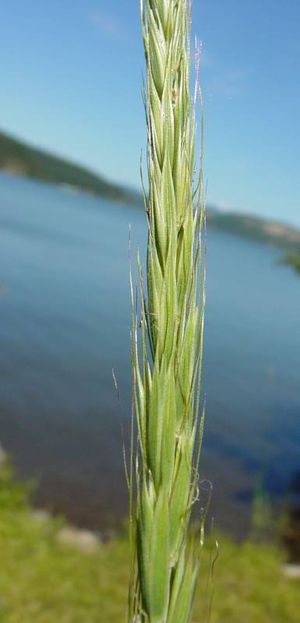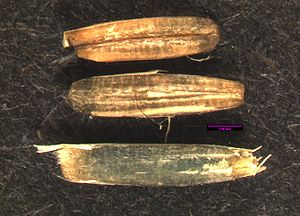Elymus glaucus
- Scientific Name: Elymus glaucus
- Family: Poaceae
- Common Names: blue wild-rye
- Codon: ELYGLA
Contents
Taxonomy
| Scientific classification | |
|---|---|
| Kingdom: | Plantae |
| Subkingdom: | Viridiplantae |
| Phylum: | Tracheophyta |
| Subphylum: | Spermatophytina |
| Class: | Magnoliopsida |
| Subclass: | Lilianae |
| Order: | Poales |
| Family: | Poaceae |
| Genus: | Elymus L. |
| Species: | Elymus Glaucus Buckley |
| Synonyms | |
| |
Description
Tufted perennial bunchgrass with terminal spikes, growing to 100 cm tall.[2] Stems erect, few per plant.[3] Few basal leaves, cauline leaf sheaths open,[2] pubescent or glabrous[4]; culms and leaf blades often glabrous;[2] ligules 1 mm, marginally haired.[4] Inflorescences with two spikelets at each node.[2] Spikelets usually with 2-6 flowers; articulation point above the glumes; glumes equal or nearly so, flattened, awns 0-9 mm,[5] 3 to 5-nerved, narrowly lanceolate and membranous;[4] lemmas awned, often glabrous, 10-12 mm long; paleas nearly equal to lemmas.[4]
Bloom Period
June - August[4]
Distribution
Alaska to California, east to the Midwest.[4]
Habitat
Open prairies, chaparral, meadows and forests with well-drained soils. High drought tolerance, disturbance adapted.[3]
Uses
Site Rehabilitation: A desirable species for use in erosion control. Blue wildrye is good for streambank restoration, meadow and swale seeding. It is also excellent for reseeding burned or disturbed areas in oak woodland or forest. Blue wildrye is not recommended to be seeded alone in revegetation plantings, and it should not make up more than 50% of the seed mix.[3]
Wildlife: Blue wildrye can also provide excellent wildlife habitat for mammals, birds, and waterfowl. It provides good forage early in the season, but later, may be too coarse and stemmy.[3]
Landscaping: The attractive, blue-green foliage adds value to commercial landscaping projects.[3]
First Nations: Blue wildrye has similar uses as creeping wild rye, primarily as a cereal grain. It is less desirable for basketry as the nodes are thick, but this does not exclude its use in some baskets. Similar to creeping wildrye, there may be some ceremonial uses of blue wildrye.[3]
Propagation
see Plant Materials Technical Note No. 17, from USDA in Portland, OR to Natural Resources Conservation Service ("Seed Production of Blue Wildrye", April 1996)
Native Plant Network Propagation Protocol
Seed
Seed sample from: 2010
Average Measurement including husk and awn: 29.8 x 1.2 x 0.9
Measurement Range including husk and awn: L: 22 – 35, W: 1 – 1.5, D: 0.5 – 1
Average Measurement without husk or awn: 5.3 x 1 x 1
Measurement Range without husk or awn: L: 5 - 5.5, W: 0.9 – 1.1, D: 0.9 – 1
Features
Shape: Awn is straight and is 5 – 6 times as long as seed body. Awn is very finely toothed.
Other Structures: Inner seed has deep longitudinal sulcus on one side and a few fine longitudinal lines on the opposite seed face.
Color: Husks off white to tan, papillose with a slight sheen. Hilium is a darker brown color. Seed is tan at the ends, and blue to green in the middle.
Surface: Seed surface is smooth and matte.
Latitudinal Cross Section: elliptical 
Longitudinal Cross Section: elliptical ![]()
Photo Gallery
References
- USDA, NRCS. 2012. Elymus glaucus Buckley ssp. glaucus – blue wildrye USDA PLANTS Profile, PLANTS Database (http://plants.usda.gov/java/profile?symbol=elgl, 7 May 2012). National Plant Data Team, Greensboro, NC 27401-4901 USA. Retrieved 05/14/2012.
- ↑ Integrated Taxonomic Information System. Retrieved from https://www.itis.gov/servlet/SingleRpt/SingleRpt?search_topic=TSN&search_value=40684
- ↑ 2.0 2.1 2.2 2.3 Bowcutt, F., & Hamman, S. (2016). Vascular Plants of the South Sound Prairies. p. 124.
- ↑ 3.0 3.1 3.2 3.3 3.4 3.5 USDA NRCS Plant Guide. Retrieved from https://plants.usda.gov/plantguide/pdf/pg_elgl.pdf
- ↑ 4.0 4.1 4.2 4.3 4.4 4.5 WTU Herbarium, Burke Museum, & University of Washington. Retrieved from https://biology.burke.washington.edu/herbarium/imagecollection/taxon.php?Taxon=Elymus%20glaucus
- ↑ Hitchcock, C. L., Cronquist, A., Giblin, D., & Legler, B. et al. (2018). Flora of the Pacific Northwest: an illustrated manual. Seattle: University of Washington Press. pp. 791-793.



